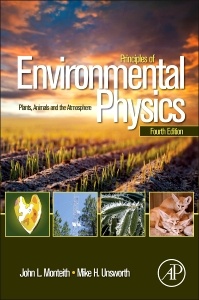Description
Principles of Environmental Physics (4th Ed.)
Plants, Animals, and the Atmosphere
Authors: Monteith John, Unsworth Mike
Language: English
Subjects for Principles of Environmental Physics:
Approximative price 85.00 €
In Print (Delivery period: 14 days).
Add to cart422 p. · 15.2x22.8 cm · Hardback
Description
/li>Contents
/li>Readership
/li>Biography
/li>Comment
/li>
Principles of Environmental Physics: Plants, Animals, and the Atmosphere, 4e, provides a basis for understanding the complex physical interactions of plants and animals with their natural environment. It is the essential reference to provide environmental and ecological scientists and researchers with the physical principles, analytic tools, and data analysis methods they need to solve problems. This book describes the principles by which radiative energy reaches the earth?s surface and reviews the latest knowledge concerning the surface radiation budget. The processes of radiation, convection, conduction, evaporation, and carbon dioxide exchange are analyzed. Many applications of environmental physics principles are reviewed, including the roles of surface albedo and atmospheric aerosols in modifying microclimate and climate, remote sensing of vegetation properties, wind forces on trees and crops, dispersion of pathogens and aerosols, controls of evaporation from vegetation and soil (including implications of changing weather and climate), and interpretation of micrometeorological measurements of carbon dioxide and other trace gas fluxes.
1. The Scope of Environmental Physics 2. Properties of Gases and Liquids 3. Transport of Heat, Mass, and Momentum 4. Transport of Radiant Energy 5. Radiation Environment 6. Microclimatology of Radiation (i) Radiative Properties of Natural Materials 7. Microclimatology of Radiation (ii) Radiation Interception by Solid Structures 8. Microclimatology of radiation (iii) Interception by Plant Canopies and Animal Coats 9. Momentum Transfer 10. Heat Transfer 11. Mass Transfer (i) Gases and Water Vapor 12. Mass Transfer (ii) Particles 13. Steady State Heat Balance (i) Water Surfaces, Soil and Vegetation 14. Steady State Heat Balance (ii) Animals 15. Transient Heat Balance 16. Micrometeorology (i) Turbulent Transfer, Profiles and Fluxes 17. Micrometeorology (ii) Interpretation of Flux Measurements
- Presents a unique synthesis of micrometeorology and ecology in its widest sense
- Deals quantitatively with the impact of weather on living systems but also with the interactions between organisms and the atmosphere that are a central feature of life on earth
- Offers numerous worked examples and problems with solutions
- Provides many examples of laboratory and field measurements and their interpretation
- Includes an up-to-date bibliography and review of recent micrometeorological applications in forestry, ecology, hydrology, and agriculture
These books may interest you

Physics of Radiation and Climate 117.69 €

Physics of Radiation and Climate 214.69 €


